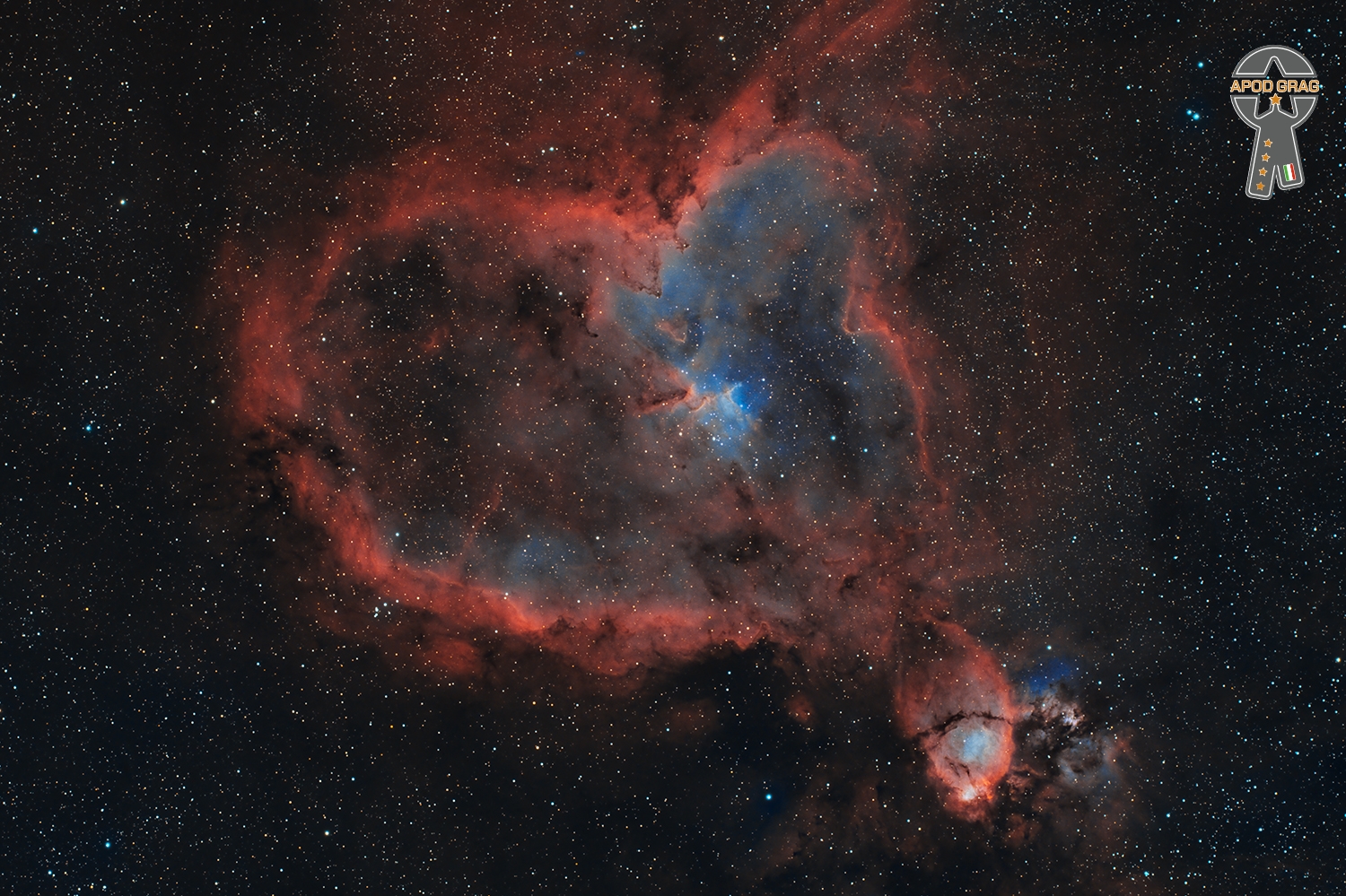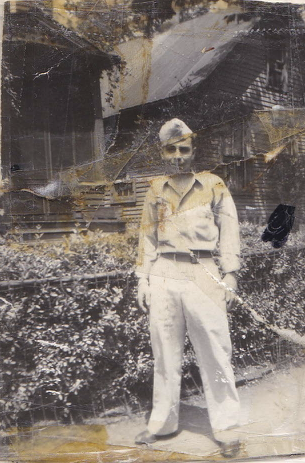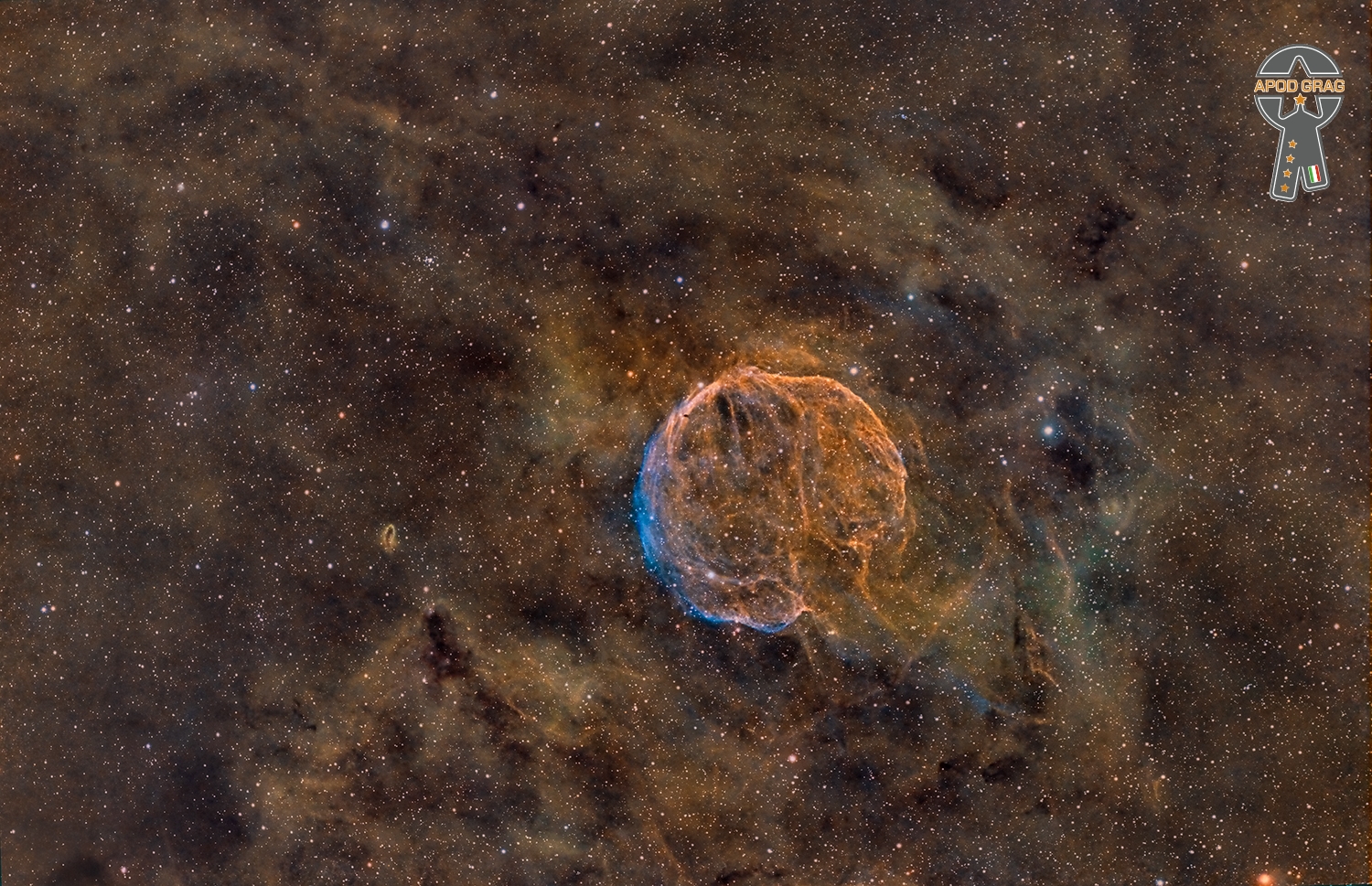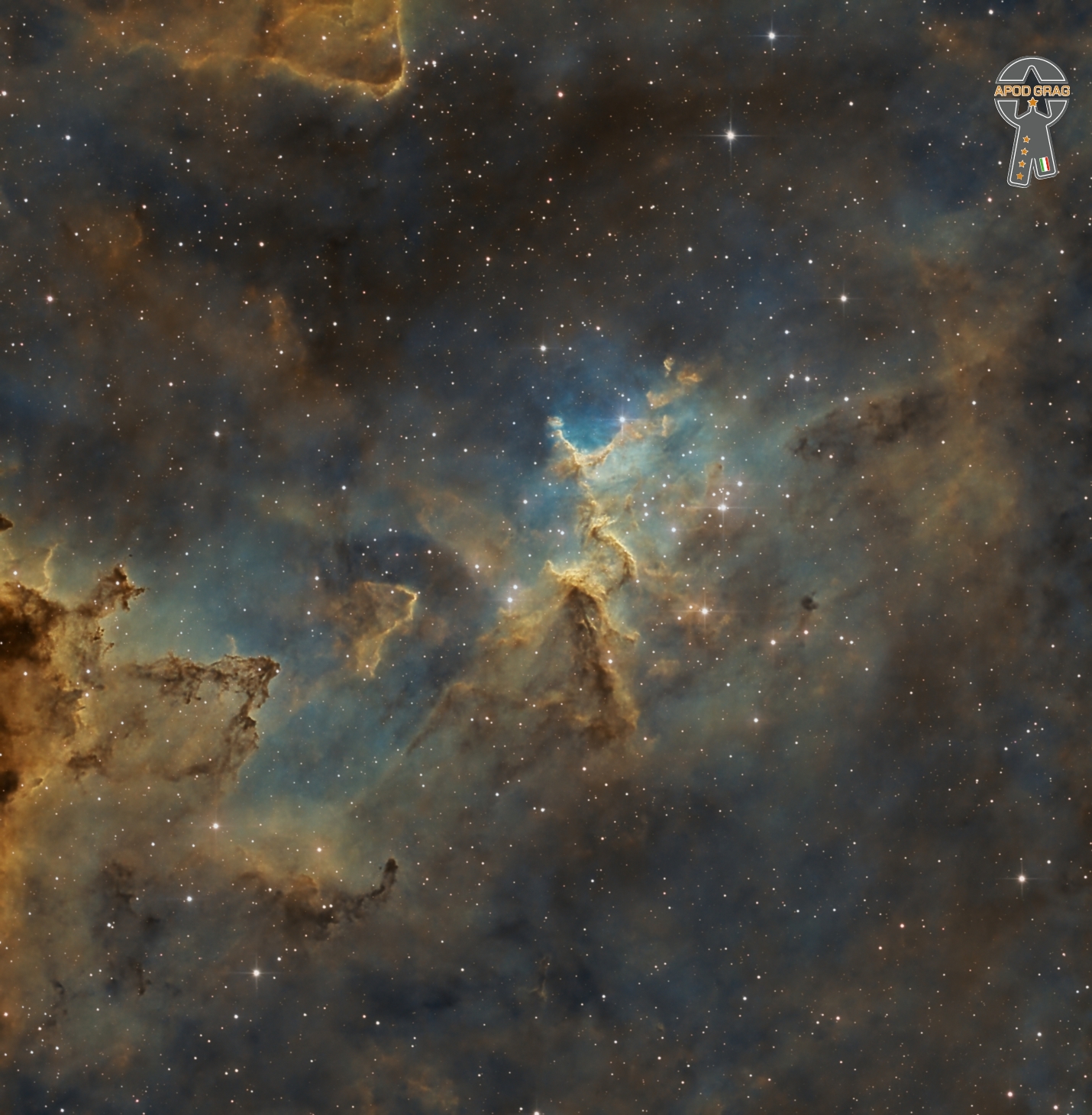Blog
The Heart Nebula (also known as the Running dog nebula), IC 1805, Sharpless 2-190, is some 7500 light years away from Earth and is located in the Perseus Arm of the Galaxy in the constellation Cassiopeia. It was discovered by William Herschel on 3 November 1787. It is an emission nebula showing glowing ionized hydrogen gas and darker dust lanes.
The brightest part of the nebula (a knot at its western edge) is separately classified as NGC 896, because it was the first part of the nebula to be discovered. The nebula’s intense red output and its morphology are driven by the radiation emanating from a small group of stars near the nebula’s center. This open cluster of stars, known as Collinder 26 or Melotte 15, contains a few bright stars nearly 50 times the mass of the Sun, and many more dim stars that are only a fraction of the Sun’s mass.
The Heart Nebula is also made up of ionised oxygen and sulfur gasses, responsible for the rich blue and orange colours seen in narrowband images. The shape of the nebula is driven by stellar winds from the hot stars in its core. The nebula also spans almost 2 degrees in the sky, covering an area four times that of the diameter of the full moon.

Baaba Maal (Fula: , born 13 June 1953) is a Senegalese singer and guitarist born in Podor, on the Senegal River. In addition to acoustic guitar, he also plays percussion. He has released several albums, both for independent and major labels. In July 2003, he was made a UNDP Youth Emissary.
Maal sings primarily in Pulaar and promotes the traditions of the Pulaar-speaking people, who live on either side of the Senegal River in the ancient Senegalese kingdom of Futa Tooro.
Maal was expected to follow in his father’s profession and become a fisherman. However, under the influence of his lifelong friend and family gawlo, blind guitarist Mansour Seck, Maal devoted himself to learning music from his mother and his school’s headmaster. He went on to study music at the university in Dakar before leaving for postgraduate studies on a scholarship at Beaux-Arts in Paris.
more...Neil Percival Young OC OM (born November 12, 1945) is a Canadian-American musician, singer-songwriter and filmmaker. After embarking on a music career in Winnipeg in the 1960s, Young moved to Los Angeles, joining Buffalo Springfield with Stephen Stills, Richie Furay and others. Since the beginning of his solo career with his backing band Crazy Horse, he has released many critically acclaimed and important albums, such as Everybody Knows This Is Nowhere, After the Gold Rush, Harvest, On the Beach and Rust Never Sleeps. He was a part-time member of Crosby, Stills, Nash & Young.
Young has received several Grammy and Juno Awards. The Rock and Roll Hall of Fame inducted him twice: in 1995 as a solo artist and in 1997 as a member of Buffalo Springfield. In 2000, Rolling Stone named Young No. 34 on their list of the 100 greatest musical artists. According to Acclaimed Music, he is the seventh most celebrated artist in popular music history. His guitar work, deeply personal lyrics and signature high tenor singing voice define his long career. He also plays piano and harmonica on many albums, which frequently combine folk, rock, country and other musical genres. His often distorted electric guitar playing, especially with Crazy Horse, earned him the nickname “Godfather of Grunge“ and led to his 1995 album Mirror Ball with Pearl Jam. More recently he has been backed by Promise of the Real. 21 of his albums and singles have been certified Gold and Platinum in U.S by RIAA certification.
Young directed (or co-directed) films using the pseudonym “Bernard Shakey”, including Journey Through the Past (1973), Rust Never Sleeps (1979), Human Highway(1982), Greendale (2003), and CSNY/Déjà Vu (2008). He also contributed to the soundtracks of the films Philadelphia (1993) and Dead Man (1995).
Young was awarded the Order of Manitoba in 2006 and was made an Officer of the Order of Canada in 2009.
more...
Wilbur Dorsey “Buck” Clayton (November 12, 1911 – December 8, 1991) was an American jazz trumpeter who was a member of Count Basie‘s orchestra. His principal influence was Louis Armstrong, first hearing the record “Confessin’ That I Love You” as he passed by a shop window.
Clayton learned to play the piano from the age of six. His father was an amateur musician associated with the family’s local church, who was responsible for teaching his son the scales on a trumpet, which he did not take up until his teens. From the age of 17, Clayton was taught the trumpet by Bob Russell, a member of George E. Lee‘s band. In his early twenties he was based in California, and was briefly a member of Duke Ellington‘s Orchestra and worked with other leaders. Clayton was also taught at this time by trumpeter Mutt Carey, who later emerged as a prominent west-coast revivalist in the 1940s. He also met Louis Armstrongwhile Armstrong was performing at Sebastian’s Cotton Club, who taught him how to glissando on his trumpet. After high school, he moved to Los Angeles. He later formed a band named 14 Gentlemen from Harlem, in which he was the leader of the 14-member orchestra.
more...Samuel Jones (November 12, 1924 – December 15, 1981) was an American jazz double bassist, cellist, and composer.
Sam Jones was born in Jacksonville, Florida, United States, to a musical family. His father played piano and drums and his aunt played organ in church.[3] In 1955, he moved to New York City and began his recording career with Tiny Bradshaw, before working with Bill Evans, Bobby Timmons, Les Jazz Modes, Kenny Dorham, Illinois Jacquet, Freddie Hubbard, Dizzy Gillespie (1958–59), and Thelonious Monk. He is probably best known for his work with Cannonball Adderley, performing in his quintet from 1955 to 1956 and then again from 1959 to 1964, and recording extensively for Riverside Records as both a leader and sideman. He later spent several years working with Oscar Peterson (1966-1970) and Cedar Walton (1972-1977). In the 1970s, Jones recorded several albums as a bandleader for the Xanadu and SteepleChase labels. Jones wrote the jazz standards “Del Sasser” and “Unit 7” while working with Adderley. Other compositions include “Blue Funk”, “O.P.”, “Bittersweet”, and “Seven Minds”.
He died of lung cancer in 1981 at the age of 57.
more...Booker T. Washington “Bukka” White (November 12, 1906 – February 26, 1977) was an American Delta blues guitarist and singer.
White was born south of Houston, Mississippi. He was a first cousin of B.B. King‘s mother (White’s mother and King’s grandmother were sisters). Bukka is a phonetic spelling of White’s first name; he was named after the African-American educator and civil rights activist Booker T. Washington. He played National resonator guitars, typically with a slide, in an open tuning. He was one of the few, along with Skip James, to use a crossnote tuning in E minor, which he may have learned, as James did, from Henry Stuckey. He also played piano, but less adeptly.
more...Honoring my dad once again on Veterans Day. A Post Traumatic victim of WWII Mike never quite recovered from his horrific experience during the war stationed in his home country of Italy.

Abell 85, located about 740 million light years from Earth. The purple emission is multi-million degree gas detected in X-rays by NASA’s Chandra X-ray Observatory and the other colors show galaxies in an optical image from the Sloan Digital Sky Survey. This galaxy cluster is one of 86 observed by Chandra to trace how dark energy has stifled the growth of these massive structures over the last 7 billion years. Galaxy clusters are the largest collapsed objects in the Universe and are ideal for studying the properties of dark energy, the mysterious form of repulsive gravity that is driving the accelerated expansion of the Universe.

Kahil El’Zabar (born Clifton Blackburn; November 11, 1953) is an American jazz multi-instrumentalist (mainly a percussionist) and composer. He regularly records for Delmark Records.
El’Zabar was born in Chicago, Illinois. He attended Lake Forest College and joined the Association for the Advancement of Creative Musicians (AACM) in the early 1970s, and became its chairman in 1975. During the 1970s, he formed the musical groups Ritual Trio and the Ethnic Heritage Ensemble, both of which remain active. Musicians with whom Kahil EL’Zabar has collaborated include Dizzy Gillespie, Stevie Wonder, Nina Simone, Cannonball Adderley, Paul Simon, Pharoah Sanders, and Billy Bang.
In 2017 the film “Be Known – The Mystery of Kahil El Zabar” by filmmaker Dwayne Johnson-Cochran was released. The documentary follows El’ Zabar and band on their 2007 Black History Month tour. The film has been available on Amazon Prime.
more...Delores LaVern Baker (November 11, 1929 – March 10, 1997) was an American R&B singer who had several hit records on the pop chart in the 1950s and early 1960s. Her most successful records were “Tweedle Dee” (1955), “Jim Dandy” (1956), and “I Cried a Tear” (1958).
Baker was born Delores Evans in Chicago. She was raised in Calumet City, Illinois. Under her mother’s new surname, McMurley, Delores – on December 23, 1948, at age nineteen, in Cook County, Illinois – married Eugene Williams.
more...Ernestine Anderson (November 11, 1928 – March 10, 2016) was an American jazz and blues singer. In a career spanning more than six decades, she recorded over 30 albums. She was nominated four times for a Grammy Award. She sang at Carnegie Hall, the Kennedy Center, the Monterey Jazz Festival (six times over a 33-year span), as well as at jazz festivals all over the world. In the early 1990s she joined Qwest Records, the label founded by fellow Garfield High School graduate Quincy Jones.
Ernestine Irene Anderson (and her twin sister Josephine) were born in Houston, Texas, on November 11, 1928. Her mother, Erma, was a housewife, and her father, Joseph, a construction worker who sang bass in a gospel quartet. By the age of three, Anderson showed a talent for singing along with her parents’ old blues 78 rpm records by the likes of Bessie “The Empress of the Blues” Smith. Anderson started singing at a local church, singing solos in its gospel choir.
more...Mose John Allison Jr. (November 11, 1927 – November 15, 2016) was an American jazz and blues pianist, singer, and songwriter. He became notable for playing a unique mix of blues and modern jazz, both singing and playing piano. After moving to New York in 1956, he worked primarily in jazz settings, playing with jazz musicians like Stan Getz, Al Cohn, and Zoot Sims, along with producing numerous recordings.
He is described as having been “one of the finest songwriters in 20th-century blues.” His songs were strongly dependent on evoking moods, with his individualistic, “quirky”, and subtle ironic humor. His writing influence on R&B had well-known fans recording his songs, among them Pete Townshend, who recorded his “Young Man Blues” for the Who‘s Live at Leeds album in 1970. John Mayall was one of dozens who recorded his classic, “Parchman Farm“, and Georgie Fame used many of Allison’s songs. Others who recorded his songs included Leon Russell (“I’m Smashed”) and Bonnie Raitt (“Everybody’s Cryin’ Mercy”).
The 1980s saw an increase in his popularity with new fans drawn to his unique blend of modern jazz. In the 1990s he began recording more consistently. Van Morrison, Georgie Fame and Ben Sidran collaborated with him on a tribute album, Tell Me Something: The Songs of Mose Allison. The Pixies wrote the song “Allison” as a tribute.
Allison’s music had an important influence on other artists, such as Jimi Hendrix, J. J. Cale, the Yardbirds, the Rolling Stones, Tom Waits, and Pete Townshend. He was inducted into the Long Island Music Hall of Fame in 2006.
Allison was born in Tallahatchie County, Mississippi on his grandfather’s farm (known as “the Island”), located outside the small unincorporated community of Tippo. The farm got the name, according to Allison, “because Tippo Bayou encircles it.” He took piano lessons at 5, picked cotton, played piano in grammar school and trumpet in high school, and wrote his first song at 13.
more...Siguirillas (also spelled Seguirillas, Seguiriya, Seguidilla- take your pick!) is an intense palo, considered cante jondo (deep song.) It’s similar to Solea in that it is profound and extremely soulful, however, it tends to be more aggressively danced if the tempo is faster. Otherwise, it can also be danced to a syrupy slow tempo.
When I first learned this rhythm, my teacher taught it as a “backward Buleria” or as a “12 count” with the accents on 12/2/4/7/10.
12 – 1 – 2 – 3 – 4 – 5 – 6 – 7 – 8 – 9 – 10 – 11 – 12 – 1 – 2 – 3 – 4 – 5 – 6 – 7 – 8 – 9 – 10
BUT it’s generally counted in fives!!! 1 and 2 and 3 and and 4 and and 5 and 1 and 2…..
1 – | – 2 – | – 3 – | – | – 4 – | – | – 5 – | – 1 – | – 2 – | – 3 – | – | – 4 – | – | – 5
The format of the dance is pretty standard, except the final fast letra (which is Bulerias for 12 count dances or Tangos for 4 count dances) is called the Macho. The Macho also serves as the estribillo(ending chorus.)
General Structure of Siguirillas:
- Falseta– melodic guitar
- Entrada– singer starts with ay, ay, ay
- Llamada– dancer “calls” the singer to sing with a percussive break
- Letra– singing verse
- Escobilla– long footwork section
- Macho– ending chorus
A major winter storm is heading for Minnesota’s North Shore today — Thursday, Nov. 10 — with gale warnings up for western Lake Superior and waves reaching as high as 12 feet.
It’s just the kind of weather the iron ore carrier Edmund Fitzgerald sailed through out of the Twin Ports as it headed for its tragic end, 47 years ago on Nov. 10, 1975.
In memory of that fateful voyage, Split Rock Lighthouse northeast of Two Harbors will mark the anniversary tonight with its annual ceremony, including tolling a bell 29 times for the crew of the Fitzgerald, and then once more.
“They call it the muster of the last watch,” said Hayes Scriven, lighthouse site manager for the Minnesota Historical Society. “Usually when all the crew members go down on a ship they do this muster. So that still kind of recognizes them, that they’re here for their watch. And it’s our way of kind of paying respect to the people that had perished on the ship. And then we added a 30th bell toll for all the sailors that were lost on the Great Lakes.”
The ceremony is scheduled to start at about 4:30 p.m. today. It’s outdoors, and the weather is expected to be blustery: The National Weather Service has issued a winter weather advisory for the area through noon Friday. The ceremony will also stream on YouTube.
Scriven said the observance also includes lighting the lighthouse beacon at Split Rock.
It went out of official service in 1969 after nearly 60 years of guiding ships through what was once called “the most dangerous piece of water in the world.” The state acquired the site in 1971, eventually turning it into a museum and visitor landmark near Two Harbors, as well as a surrounding state park.
The landmark has been restored to its original operating condition, and the beacon will be lit Thursday night for a couple hours, shining across the November waves.
“We’ve kind of restored it back to its 1910 operation. We still run everything with a hand crank. Every two hours we need to rotate the crank again to make sure the lens is still spinning,” Scriven said. “It’s a third-order Fresnel lens with a 1,000 watt incandescent bulb in there. So it’s kind of like a big theater light that shines out 22 miles over the lake”.
more...The Heart Nebula (also known as the Running dog nebula), IC 1805, Sharpless 2-190, is some 7500 light years away from Earth and is located in the Perseus Arm of the Galaxy in the constellation Cassiopeia. It was discovered by William Herschel on 3 November 1787. It is an emission nebula showing glowing ionized hydrogen gas and darker dust lanes.

More Posts
- Barney Kessel
- Cozy Cole
- World Music Constantinople & Accademia del Piacere
- Daily Roots Gadfrey Lewis
- Roger Hawkins
- Cosmos PK 164+31.1
- Bob Weir
- Emile Ford
- Roy Hargrove
- Big Joe Williams
- World Music Trio Mandili
- Daily Roots Nicky Thomas
- Cosmos M90
- N. Ramani
- Fela Kuti
- Freddie Cole
- Mickey Baker
- World Fusion Gao Hong · Ignacio Lusardi Monteverde
- Daily Roots Valentine Brodie
- James “Son” Thomas